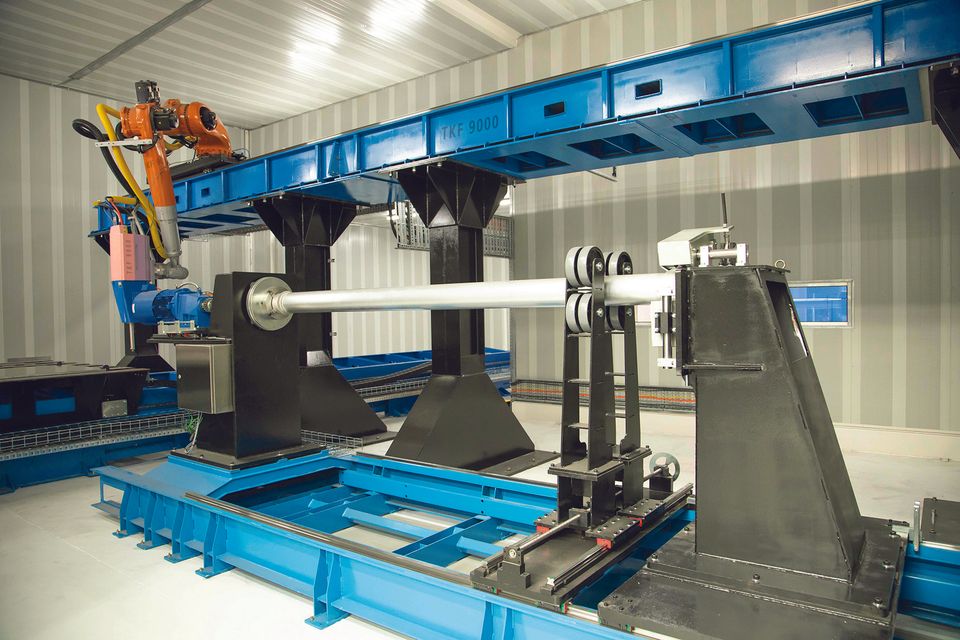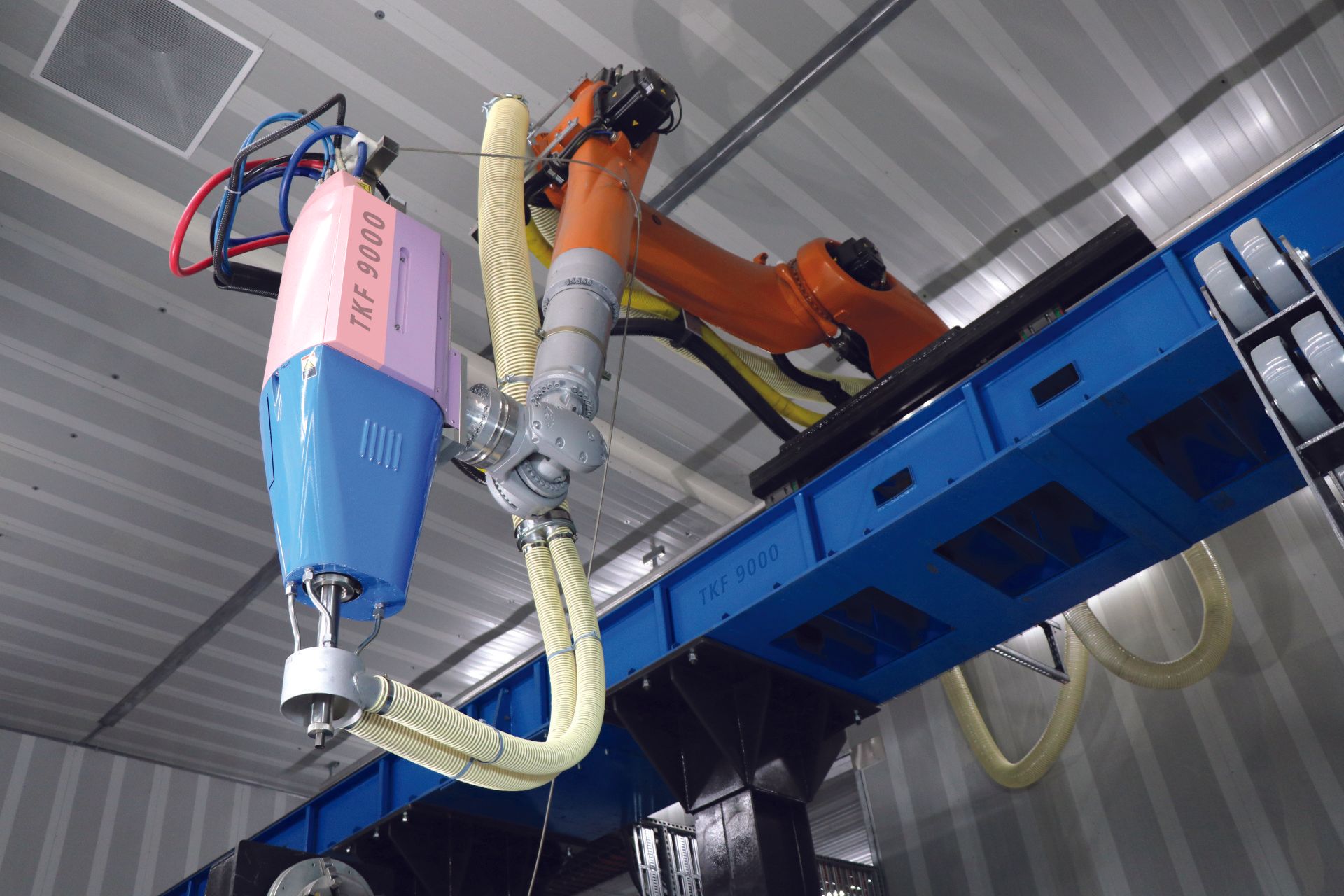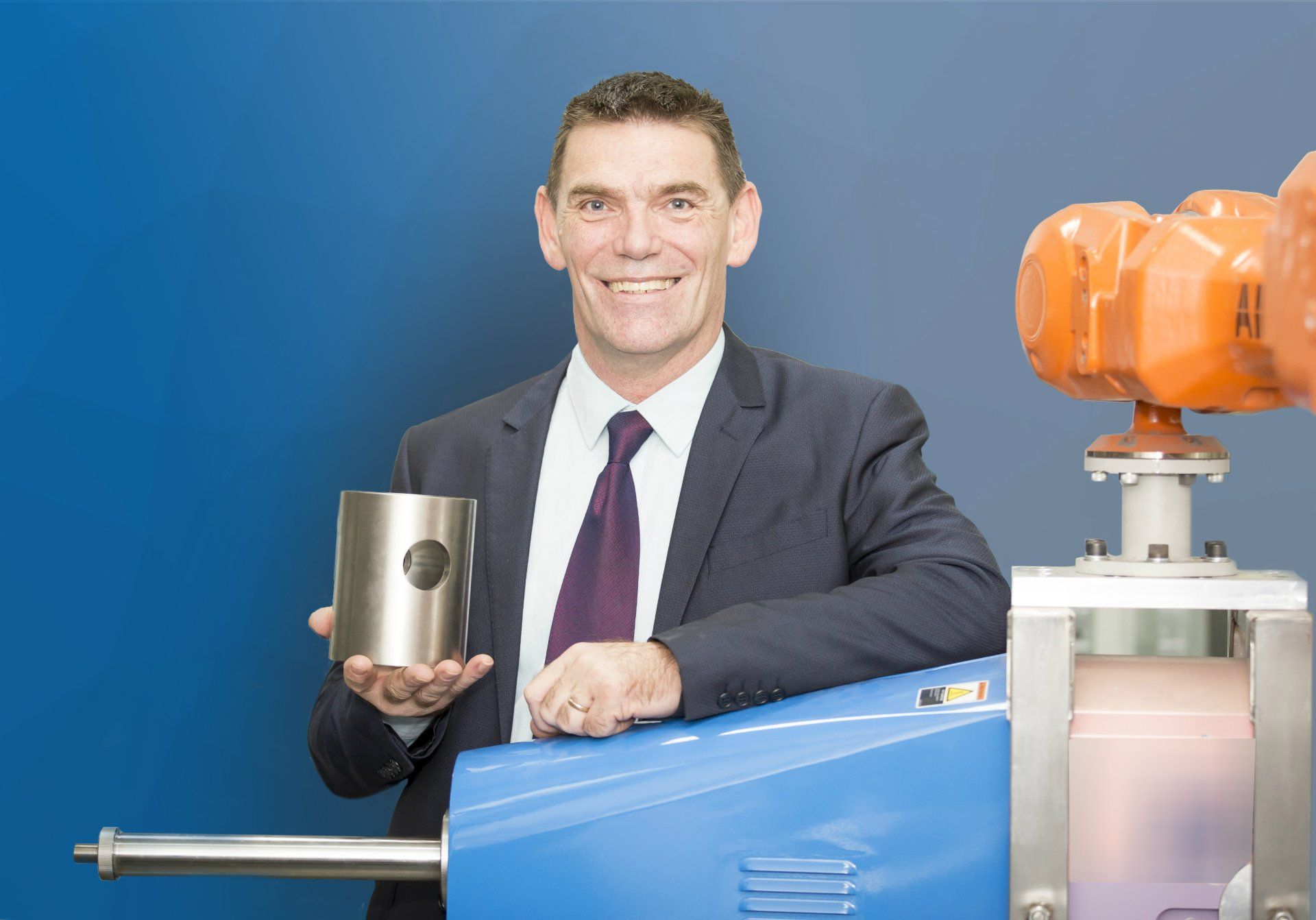Australia’s titan of titanium
Staff Writers
ASX-listed Titomic is building a manufacturing industry from scratch – incorporating 3D printing with Australia’s natural advantages

World’s largest: the TKF 9000 has a 40.5 cubic metre build capacity
In reality, innovation is process driven, focused, and works towards a specific purpose.
Titomic is a great example, the company was born out of a goal to create an industry from a natural resource. Australia has vast reserves of titanium in its soil, a metal with properties which makes it perfect for the growing aerospace, defence, shipbuilding, automotive, and mining sectors.
Titanium resists corrosion, can withstand the high-temperatures of atmospheric entry and re-entry, and is an incredible hard material, making it suited for the defence sector. While it is the 4th most common element in the Earth’s crust, Australia has 24 million tones of it, which is 50 per cent of the world’s supply.
This is why in 2007, the Government went out and asked: How could Australia build an industry around a natural resource?
With funding from the Federal Government, Titomic worked with CSIRO and came up with a new way of using titanium powder in manufacturing, in a cold-spray process which came to be known as Titomic Kinetic Fusion. The metal additive manufacturing (colloquially known as 3D-printing) process uses ‘cold-fusion’ to blend materials, by making particles collide at supersonic speeds, with the resulting energy allowing them to fuse.
The patented process renders the use of heat superfluous, allowing the company to blend materials which would normally have different melting temperatures.
Alongside titanium, Titomic can digitally manufacture metal parts and complex surface coatings of super alloys and dissimilar metals such as nickel, copper, scandium and alloys such as stainless steel, inconel, and tungsten carbide.
With this ability, Titomic can manufacture parts that it says are unobtainable via other manufacturing methods, enabling it to exploit the mechanical benefits of multiple high-performance alloys simultaneously.
Jeff Lang is the managing director of Titomic, and a fierce advocate for Australia’s sovereign capabilities, particularly in the manufacturing sector. Having seen Australia fail to capitalise on its resource boom in iron ore, he is trying to lead the way to ensure the country maximises the potential of its titanium resources.
“It is important to understand that Australia is in a good position to maximise our economic opportunities.
“We are resource rich, and will become important for a global supply chain. Australia does not yet understand the opportunity that comes with a global market. Australia is good at representing ourselves as pioneers, and we have an exploring attitude that makes us want to solve problems. We do not shy away from global problems. Australians are good at nutting it out and solving problems.”
The young company already has a contract with Boeing to produce protoype parts for the company, allowing the aerospace giant to significantly reduce its lead times, and cut down from the 80% waste that comes with traditional manufacturing methods.
As Lang explains, “At Titomic, we see ourselves as a solution provider, Companies come to us with technical problems and no idea how to solve it. We solve that with symbiosis.
“Many traditional industries want to move towards digital manufacturing, but are unsure as to how they can do so, while being concerned about the disruption involved.
“We offer digital manufacturing solutions which de-risk that move for them.”
Using the past to predict the future
Titomic is not averse to thinking in the big-picture, and planning several years ahead. Its grand vision is a fully-integrated digital platform that collects and collates all the information from the full manufacturing process, from mining, to transport, to production, and beyond.
With a goal as large as Titomic’s, an interconnected hub of manufacturing around the globe, with centralised cloud-information optimising the performance of each silo, you need a purpose-built digital platform.
The company approaches this is an orderly fashion, with teams working in concentrated bursts of activity over three-month periods, building pieces of the platform individually, scaling it up and integrating it.
The end goal is to use the past to predict the future, where you start by collecting copious amounts of data.
You draw information while mining the titanium, from the weather patterns in the region, the chemistry of the batch, through to the production of the parts for a submarine or aircraft from the powder.
“There would be an existing data mould, covering the whole history of the material,” explains Lang.
From here, you can trace the products performance in the environment, and then use AI technology to crunch the mass amount of data, making connections between seemingly disparate pieces of information possible.
Once there are parallels drawn, Titomic can start to predict the performance of materials based on the information the company holds about their origin.
“With smart technologies collecting the huge amounts of data available in the system we can do a lot more. It is about more sustainable manufacturing, lessening the waste of resources, with more efficient production,” says Lang.
Super-bureaus training talent, growing business
By building a digital platform for its technology, the Titomic manufacturing process is not limited by geography or location. With the commission of a 3D printer, the company can repeat its Australia operations elsewhere, by following the formula.
As Titomic expands worldwide, it plans on creating 10-15 global manufacturing bureaus, able to produce repeatable parts year-in-year out, working with OEM manufacturers with a determined rate of return on the investment. One such example may be for an aerospace company producing a tooling system.
Then, there are its ‘super-bureaus’, hosting 50-100 staff, including PHD students in training.
Priced at $30m-$50m to set up, the company can then use the super bureaus as R&D hubs, producing new digital blueprints for parts, which can then be produced at any bureau around the world.
The super bureaus also become training centres, where users can get certification on using the equipment.
Titomic currently has a staff of 50, with a clear goal of 500 globally by 2024. The plan is to achieve a billion dollar market cap, moving towards a billion dollars in revenue.
As Lang explains, “Everyone that works for the company is passionate about what we are trying to achieve and working towards it.
“We have deliverables as a public company, but at the same time we are exploring what keeps the staff happy, what makes them want to come to work and give their best to the company.”
Science-fiction applications
While Titomic has already broken ground in its applications, creating the world’s largest titanium UAV (Unmanned Aerial Drone), with a diameter over 1.8m, it is also looking to the future.
It is now looking into printers that would be able to print structures on the moon, and Mars, paving the way for the next generation of space exploration, with Lang pushing for Australia to be a major player.
“One of the highest capabilities that humans can achieve is our ability to travel into space. Australia is in a viable position to be the leader.
We could be the Switzerland of the space sector – a neutral country from which others can launch rockets and satellites,” says Lang.
“We are the least threat to any sovereign state around the world, and have a good relationship with both China and the US.
“Australia is at an interesting point in its history, like a teenager defining itself and learning to live independently of its traditional parents, the US and UK.
“It is a maturity thing – we need to envisage what we want to represent, what we want to push out into the world.”
Fighting tall-poppy syndrome
The former professional athlete believes that Australia suffers from isolation at times, failing to properly realise its importance on the world stage.
“We see ourselves so far from the rest of the world, we have siloed thinking. Combined with that is Australia’s tall-poppy syndrome, the cultural predisposition to want to heckle and tear down people that are successful, which has not worked well for the country.
“How do we instead propagate the good things about being Australian? The pioneering spirit, the unique capability in how we approach problems?
“We try to tap into that at Titomic. With our digital manufacturing platforms, there is no aspect of location. It is not constrained by borders or physical boundaries; it connects the world together.”
This is where Australia needs to move its mindset in manufacturing: seeing itself as an important player on the world stage, offering an approach, attitude, and skill set that is desired by some of the biggest companies on the planet. It is about having the confidence to take risks, define big, long-term goals, and have the audacity to give it a crack.
Titomic has given a roadmap as to how it can be achieved, with a team of experts including those with experience at NASA, and major corporations, bringing a diverse skillset together.
As Lang puts it, “When you are out there providing viable solutions to Government and industries no-one will push back. No-one asks questions when things are working, you just have to stand up and do it.”
This piece is taken from our upcoming book, Australia's Nobel Laureates, Vol. III, celebrating Australian science and innovation. Taking a whole-of-economy healthcheck on Australia's innovation ecosystem, the book features words from industry, academia, and Government.

In 2016 I published a blog article titled Moonshots for Australia: 7 For Now. It’s one of many I have posted on business and innovation in Australia. In that book, I highlighted a number of Industries of the Future among a number of proposed Moonshots. I self-published a book, Innovation in Australia – Creating prosperity for future generations, in 2019, with a follow-up COVID edition in 2020. There is no doubt COVID is causing massive disruption. Prior to COVID, there was little conversation about National Sovereignty or supply chains. Even now, these topics are fading, and we remain preoccupied with productivity and jobs! My motivation for this writing has been the absence of a coherent narrative for Australia’s business future. Over the past six years, little has changed. The Australian ‘psyche’ regarding our political and business systems is programmed to avoid taking a long-term perspective. The short-term nature of Government (3 to 4-year terms), the short-term horizon of the business system (driven by shareholder value), the media culture (infotainment and ‘gotcha’ games), the general Australian population’s cynical perspective and a preoccupation with a lifestyle all create a malaise of strategic thinking and conversation. Ultimately, it leads to a leadership vacuum at all levels. In recent years we have seen the leadership of some of our significant institutions failing to live up to the most basic standards, with Royal Commissions, Inquiries and investigations consuming excessive time and resources. · Catholic Church and other religious bodies · Trade Unions · Banks (and businesses generally, take casinos, for example) · the Australian Defence Force · the Australian cricket teams · our elected representatives and the staff of Parliament House As they say, “A fish rots from the head!” At best, the leadership behaviour in those institutions could be described as unethical and, at worst….just bankrupt! In the last decade, politicians have led us through a game of “leadership by musical chairs” – although, for now, it has stabilised. However, there is still an absence of a coherent narrative about business and wealth creation. It is a challenge. One attempt to provide such a narrative has been the Intergenerational Reports produced by our federal Government every few years since 2002. The shortcomings of the latest Intergenerational Report Each Intergenerational Report examines the long-term sustainability of current government policies and how demographic, technological, and other structural trends may affect the economy and the budget over the next 40 years. The fifth and most recent Intergenerational Report released in 2021 (preceded by Reports in 2002, 2007, 2010 and 2015) provides a narrative about Australia’s future – in essence, it is an extension of the status quo. The Report also highlights three key insights: 1. First, our population is growing slower and ageing faster than expected. 2. The Australian economy will continue to grow, but slower than previously thought. 3. While Australia’s debt is sustainable and low by international standards, the ageing of our population will pressure revenue and expenditure. However, its release came and went with a whimper. The recent Summit on (what was it, Jobs and Skills and productivity?) also seems to have made the difference of a ‘snowflake’ in hell in terms of identifying our long-term challenges and growth industries. Let’s look back to see how we got here and what we can learn. Australia over the last 40 years During Australia’s last period of significant economic reform (the late 1980s and early 1990s), there was a positive attempt at building an inclusive national narrative between Government and business. Multiple documents were published, including: · Australia Reconstructed (1987) – ACTU · Enterprise Bargaining a Better Way of Working (1989) – Business Council of Australia · Innovation in Australia (1991) – Boston Consulting Group · Australia 2010: Creating the Future Australia (1993) – Business Council of Australia · and others. There were workshops, consultations with industry leaders, and conferences across industries to pursue a national microeconomic reform agenda. Remember these concepts? · global competitiveness · benchmarking · best practice · award restructuring and enterprising bargaining · training, management education and multiskilling. This agenda was at the heart of the business conversation. During that time, the Government encouraged high levels of engagement with stakeholders. As a result, I worked with a small group of training professionals to contribute to the debate. Our contribution included events and publications over several years, including What Dawkins, Kelty and Howard All Agree On – Human Resources Strategies for Our Nation (published by the Australian Institute of Training and Development). Unfortunately, these long-term strategic discussions are nowhere near as prevalent among Government and industry today. The 1980s and 1990s were a time of radical change in Australia. It included: · floating the $A · deregulation · award restructuring · lowering/abolishing tariffs · Corporatisation and Commercialisation Ross Garnaut posits that the reforms enabled Australia to lead the developed world in productivity growth – given that it had spent most of the 20th century at the bottom of the developed country league table. However, in his work, The Great Reset, Garnaut says that over the next 20 years, our growth was attributable to the China mining boom, and from there, we settled into “The DOG days” – Australia moved to the back of a slow-moving pack! One unintended consequence of opening our economy to the world is the emasculation of the Australian manufacturing base. The manic pursuit of increased efficiency, lower costs, and shareholder value meant much of the labour-intensive work was outsourced. Manufacturing is now less than 6% of our GDP , less than half of what it was 30 years ago!












